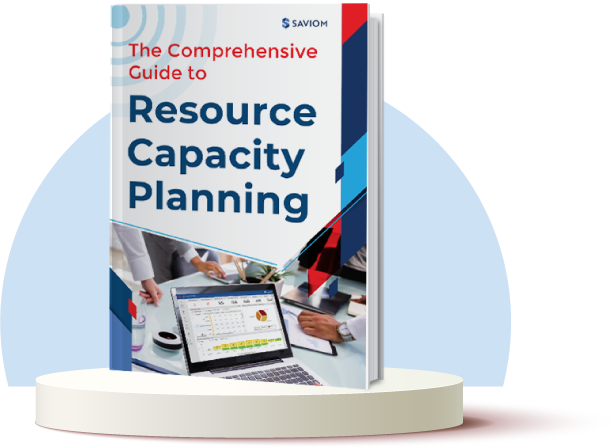Architecture, Engineering, and Construction (AEC) is a rapidly growing industry with an expected CAGR of 10.7% from 2021 to 2028.
This growth can be attributed to the increased demand for real estate, advanced technologies, and more. The AEC projects can range from constructing skyscrapers to government projects such as building bridges, etc. Like every other industry, resources are the focal point of AEC projects as their efforts and skills steer the project to succeed. However, building an optimized workforce while ensuring every project is delivered successfully is easier said than done.
Making the right resource available at the right time involves techniques such as forecasting and resource capacity planning.
The pertinent question is, what is resource capacity planning and how to implement it in the AEC industry?
This informative article will address the query and delve deep into this concept. Let’s get started.
What is the AEC industry?
AEC stands for Architectural, Engineering+, and Construction, which describes the collaboration of architects, engineers, and construction professionals on construction-related work such as designing, concreting, carpentry, plumbing, electrical work, etc.
Let’s understand each sector in-depth:
Architectural – Visual aesthetics are an essential component of any construction project. Architects design durable, functionally safe, and aesthetically pleasing buildings. They stay involved in the project from the conceptual stage till completion, create plans according to client needs, environmental factors, and budget. The Architecture department is responsible for:
- Creating designs and drawings based on the client’s requirements.
- Coalescing with the team to quantify and qualify the project w.r.t regulations, budget, and site characteristics.
- Coordinate with engineering/construction teams and validate the work.
Engineering – AEC industry requires civil, mechanical, and electrical engineers. It includes professionals who evaluate and execute the structural, mechanical, and electrical requirements of different AEC projects. The key responsibilities of the engineering department are:
- Evaluate the designs, and understand the material and equipment requirements before the construction work begins.
- Ensure the materials comply with the required quality.
- Identify and resolve technical issues in the construction process.
Construction – In the most widely used context, the construction sector is associated with structural additions, infrastructure, and industrial facilities. The construction managers coordinate with architects, engineers, and laborers to ensure the timely completion of the construction project. In addition, the construction department oversees the following activities:
- Coordinate with architects and engineers to build the construction plan
- Hire construction workers and delegate tasks.
- Manage relationships with clients and AEC professionals
- Supervise the entire construction and identify and mitigate potential risks
By integrating these seemingly independent sectors into one industry – architects, engineers, and construction, managers can work more efficiently to attain the common goal.
Now that we know what AEC comprises, let us understand the list of resources required for project execution.
Key resources in the AEC industry
Different human and non-human resources are required to bring the construction projects to fruition.
Human resources
- Contractor – The contractor is responsible for planning, leading, and supervising the construction work.
- Supervisor – The construction supervisor is the bridge between contractors and construction workers in the field.
- Estimator – The estimator estimates the cost of material and labor required to work on the project.
- Surveyor – The surveyor advises the clients on style=”margin-bottom: 15px;”contractual matters and building costs throughout the construction process.
- Others – Other than the roles mentioned above, multiple other professionals work to bring AEC projects to fruition. For instance, architects envision the client’s needs and develop blueprints. Engineers oversee electrical, mechanical, and civil activities, and so on.
Non-human resources
- Equipment – Construction equipment refers to heavy-duty vehicles and machinery specially designed for executing construction and engineering activities. For example, excavators are used for heavy lifting & demolition, bulldozers are used to remove rock strata or soil, etc.
- Materials – Materials such as – fittings, tools, software, systems, timber, thatch, stone, steel, concrete, etc., are required to complete the construction.
- Facilities – In the AEC industry, facilities include the necessary amenities such as storage sheds, field office, safety requirements, living accommodation, fire protection, etc.
Read More: All You Need To Know About Construction Resource Management
Characteristics of the AEC industry
AEC projects are highly structured endeavors owing to long-term commitments and the demand for a coalition of three departments. These are extremely fluid, which means the changes in weather, equipment, technology, and permits can wreak havoc on a project’s schedule.
Here are some key characteristics –
- AEC projects are resource-driven. From highly skilled architects to engineers and on-site workers, they require diverse expertise. According to the US Bureau of Labour and Statistics, job opportunities in the construction industry are expected to reach 7.5 million by 2026.
- Each construction project is unique and is attributed to geographical conditions. For instance, if two identical dams are to be constructed at two different places, the soil properties, site characteristics, climatic conditions, environment, etc., will introduce multiple variations in the project requirements.
- A bulk labor force is engaged in construction whose employment pattern and working conditions are different from other industries. For example, the construction workers in the field are not selected based on their certifications or academic qualifications, they are solely recruited based on their manual skills. Additionally, they are often employed on an ad-hoc basis and paid hourly wages, encouraging them to work for a longer duration.
- Most AEC firms operate in silos where departments use independent software to function or still use spreadsheets. Many companies still employ outdated data processors and controllers to export/import data from the systems.
Read More: What Makes a Construction Project Fail?Subject to these traits, often AEC industries find it challenging to employ the right personnel. The following section explains these resourcing challenges and how effective capacity planning can help overcome them. Let’s delve deep,
Resourcing challenges faced by the AEC industry and how to overcome them
There are many pitfalls in the construction project lifecycle. According to a study, 77% of AEC projects suffer delays, and 98% go over budget.
So, what is the leading cause of these issues? Here is a look at what’s affecting the industry –
Ineffective scheduling of AEC resources due to siloed information
As mentioned above, multiple resources, including civil engineers, CAD designers, carpenters, plumbers, equipment operators, etc., are required to complete an AEC project.
Failing to plan and schedule the resources appropriately can impact the quality, delivery, and overall project success.
Many firms still use legacy systems and traditional spreadsheets, which often lead to siloed data and a lack of visibility into resources’ present and future schedules. This can lead to double-booking, unnecessary hiring, etc.
For example, construction laborers work on a shift basis, and due to a lack of visibility into their bookings– managers might book the same laborer in two shifts, causing an excessive workload.
Solution: A robust resource management tool helps break down the silos within an organization by providing enterprise-wide visibility of resource schedules. With a unified Gantt chart view, managers can book the resource using simple drag and drop capability and make amendments when required. Additionally, the tool provides a warning if any resource is booked more than the capacity and helps prevent overutilization.
Moreover, the real-time utilization and availability reports help managers make informed decisions and ensure uniform workload distribution.
Read More: What is Resource Scheduling? How to Schedule Resources for Projects Efficiently?
Growing shortage of skilled engineers & construction workers
‘Aging workforce’ closer to retirement is one of the major resourcing bottlenecks for AEC industries. According to a recent survey, only 3% of young people were interested in pursuing their careers in the construction field. So, due to the current resources retiring and the lack of a new generation workforce, there is an acute labor shortage in the AEC industry.
Moreover, there is an increasing demand for skilled talent because of ever-evolving customer expectations, global competition, and rapid technological improvements. As a result, many construction firms are looking for professionals with advanced skills like – AutoCAD, Rhino 3D, SketchUp, Revit Architecture, etc. Since the existing talent pool is not well versed with these tools and tech, the skills gap is widening tremendously.
So, what is the best possible resolution?
Solution: With a forecasting and resource capacity planning solution, managers can foresee project demand and identify the skills gap in advance. They can leverage the capacity vs. demand reports to assess the excess and shortage of resources and implement corrective measures ahead of time.
If there is any skill gap, they can train/upskill the existing workforce in the latest technologies mentioned above. In case of resource shortage, they can even initiate planned hiring to recruit competent resources and ensure the seamless execution of future construction projects.
Read More: How Can Retraining/Upskilling Future-Proof Your Workforce?
Lack of foresight into pipeline AEC projects
Many organizations still use legacy systems such as excel spreadsheets or desktop applications to manage AEC projects. As a result, they fail to foresee pipeline projects’ demand.
Due to a lack of foresight in projects, the construction managers end up requesting workers at the last minute, leaving no room to form an action plan. It may lead to last-minute firefighting for resources, wrongful hiring leading to compromised project quality, budget and schedule overruns, etc.
Solution: Construction managers can foresee an opportunity that is at an approval stage or has reached a certain probability of closure and estimate resource requirements well ahead of the curve.
Then using the resource management software, the project managers can request resources and provide enough lead time to deploy the right ones at the right cost. In case a critical resource such as an architect or engineer is allocated to an ongoing project, managers can implement out rotation and backfill strategy to ensure the construction activities are not disrupted.
Increase in bench size in the construction firms
The majority of AEC projects are prone to frequent ramp-ups/downs. Typically, they include phases: initiation, pre-construction, procurement, construction, and closeout. For example, the manager may require thousands of workers in the procurement and construction phase.
However, once the project reaches the closeout phase, there can be a massive ramp down of resources. Due to this, most of the workforce (typically construction workers and engineers) land on the bench, impacting overall business profitability.
Solution: Managing the capacity of resources and minimizing bench time is one of the main aspects of a construction/industrial project. To achieve this, managers can implement resource management solutions and leverage project vacancy and people on the bench reports. This will help them get foresight into resources likely to end up on the bench and allocate them appropriate project tasks (from the project vacancies) beforehand. Moreover, the managers can also provide upskilling/training to benched employees and utilize them on future projects.
Read More: How to Balance Ramp-Ups and Ramp-Downs in a Project?
Inability to meet the volatile resource demand
The AEC industry is one of the volatile markets with increasing uncertainties and risk factors. According to a report by KPMG, 78% of engineering and construction companies believe that the risks of construction projects are increasing.
Since AEC projects are susceptible to change due to external and uncontrollable factors, the resource demand is volatile and can change dynamically. For example, if you are working on building a shopping mall, the initial idea was to keep it 4 storeyed. However, the client requests you to add one more.
Due to a lack of visibility into the resource pool, managers are not in a position to fulfil this demand cost-effectively. How can one combat this?
Solution: To meet the volatile resource demand, managers can form a balance of permanent and contingent workforce.
Before forming the mix, resource managers can go through the current and future resource demand, evaluate if it’s one-time or recurring and make an informed decision.
Considering the previous example, managers can hire a contractual resource (engineer and supervisor) to oversee the 5th floor’s construction along with a mix of permanent and freelance manual labor to keep the costs in check.
Read More: Beat Market Volatility With Efficient Resource Capacity Planning
Let’s go through some more tips to improve resource capacity planning.
Additional tips for AEC managers
Construction projects are more likely to be delivered on time when the resource capacity planning is done right. However, managers can implement additional tips to ensure successful delivery,
- Facilitate collaboration between departments to manage interdependencies, foster trust, empower the workforce and boost productivity.
- Bring transparency in communication and set expectations right to ensure everyone is on the same page. Lack of transparency in defining goals and objectives can lead to discrepancies and conflicts.
- Keep track of workforce competency across the enterprise. It helps to proactively plan for niche skills needed in a new construction project
- Monitor billable, strategic and overall utilization of resources and take corrective measures to ensure profitable utilization.
Final thoughts
The AEC projects are complex, resource-intensive, and of long-duration. To ensure timely delivery, AEC firms have to ascertain they have an optimized workforce in all three areas. It’s about time they implemented a robust resource forecasting and capacity planning solution to build an optimized workforce and futureproof them against market volatilities.
How do you tackle your resourcing bottlenecks?
The Glossary
Read More: Glossary of Resource Workforce Planning, Scheduling and Management
The SAVIOM Solution
SAVIOM is the market leader in offering the most powerful and configurable solutions for managing enterprise resources efficiently and effectively. Having more than 20 years of experience, this Australian-based MNC has a global presence in over 50 countries. It is also popular with more than 100 customers and helps them achieve their business goals. SAVIOM also has products for project portfolio management, professional service automation, and workforce planning software which can be easily customized as per business requirements.













Leave a Reply